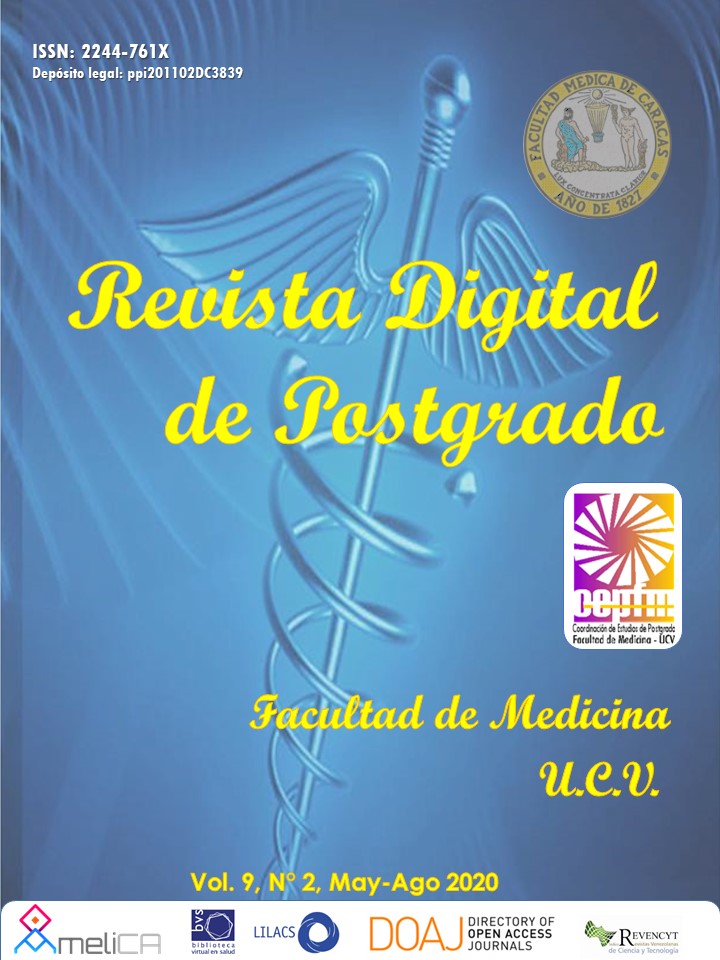Flow blocks in pediatric patients
Keywords:
Caudal block, Analgesia, Pain intensity, Hemodynamic changes and Adverse effects.Abstract
This research characterizes the hemodynamic behavior of pediatric caudal blocks subjected to surgeries of the lower hemiabdomen and inguinal region, in the General Teaching Hospital of Calderón (HGDC), Quito-Ecuador, in the period June-December 2019; Furthermore, the demographic characteristics of the study population are described, determining the intensity of pain with the visual analog scale (VAS). Likewise, hemodynamic changes are reported at the different times established in the study, verifying the use of rescue analgesics and the search for adverse effects with the use of this technique. This is a retrospective descriptive study, considering the entire study population (32 patients). Statistical analysis was performed with measures of frequency and central tendency (median), dispersion (standard deviation, range). Regarding the results of the VAS, it is important to highlight that despite giving a statistically significant difference (p <0.05), in medical practice this scale remains below 1 point, that is, mild pain; hemodynamic variables remained stable with respect to pre lock. With the use of rescue analgesics, only a 3.1% patient was reported, who was administered rescue doses. The adverse effects reported with caudal block were: nausea 6.3%, somnolence 3.1%, and no effect with 90.6% respectively. The caudal block provides excellent postoperative analgesia according to the VAS at the different times in the study.Downloads
References
López R. Manejo del dolor postoperatorio en pediatría. Rev.Mex.Anestesiol. 2017; 40(1):374-375.
Pérez A. Aragón M, Torres L. Dolor postoperatorio: ¿hacia dónde vamos? Rev Soc Esp Dolor. 2017; 24(1):1-3
García G. Bloqueo caudal. Rev.Mex.Anestesiol. 2016; 39(1):257-258.
Rodríguez J, Delfino P, Moreno I. Anestesia general versus anestesia caudal en la hipertrofia pilórica. Rev.Mex. Anestesiol.2018; 41(1); 25-26.
Lönnqvist Per-Arne. Asleep or awake: is paediatric regional anaesthesia without general anaesthesia possible? British Journal of Anaesthesia. 2020; 125, Issue 2:115-117.
Ríos A, Caicedo J, Vásquez M, Aguille O, Gonzales M. Anestesia regional en pediatría, revisión no sistemática de la literatura. Rev Colomb Anestesiol. 2015; 43(3): 204-213.
Dadure C, Sola C, Dalens B, Capdevila X, Miller. Anestesia. Anestesia regional en niños. 8va Ed. España: Elsevier; 2016.
Fitzgerald L. Pediatric Anesthesia and Emergency Drug Guide. 2a Ed. Burlington: Jones & Bartlett Learning; 2017
Moriarty A. Pediatric epidural analgesia (PEA). Paediatr Anaesth. 2012; 22:51-55.
Tamayo y Tamayo M. El proceso de la Investigación Científica. 5ta Ed. México: Editorial LIMUSA; 2011.
Melman E, Zaragoza G. Anestesia regional en pediatría. Rev.Mex.Anestesiol. 2018;41(3):213-227.
Adetoye A, Adenekan A, Faponle O, Sowande O, Owojuyigbe A. Caudal bupivacaine and midazolam versus bupivacaine alone for pain relief in paediatric ambulatory groin surgeries. PACCJ.2017;5(2):95-102.
Flores M, Hernández M. Bupivacaina-buprenorfina vs bupivacaina por vía caudal para analgesia postoperatoria en el paciente pediátrico en cirugía ortopédica. Rev. Soc. Esp. Dolor. 2011;18 (2): 84-90.
Peñalosa C, Marín A. Efectos hemodinámicos en bloqueo caudal con bupivacaina en niños/as sometidos a cirugía de hemicuerpo inferior. Hospital José Carrasco Arteaga, Cuenca enero 2014 julio 2015. Universidad de Cuenca. [internet]. 2016. [cited 2019 November 12]. Available from: http://dspace.ucuenca.edu.ec/bitstream/123456789/25406/1/TESIS.pdf
Yang Y, Ling Yu, Wen S. Clonidine versus other adjuncts added to local anesthetics for pediatric neuraxial blocks: a systematic review and meta-analysis. J Pain Res. 2018; 11: 1027-1036.
Ecoffey C. Safety in pediatric regional anesthesia. Paediatr Anaesth. 2012; 22:25-30.
Wiegele M. Marhofer P, Lonnqvist P. Caudal epidural blocks in paediatric patients: a review and practical considerations. BJA. 2019; 122 (4): 509-517.
How to Cite
Issue
Section
License
Usted es libre de:
- Compartir — copiar y redistribuir el material en cualquier medio o formato
- Adaptar — remezclar, transformar y construir a partir del material
- para cualquier propósito, incluso comercialmente.
Bajo los siguientes términos:
-
Atribución — Usted debe dar crédito de manera adecuada, brindar un enlace a la licencia, e indicar si se han realizado cambios. Puede hacerlo en cualquier forma razonable, pero no de forma tal que sugiera que usted o su uso tienen el apoyo de la licenciante.
- No hay restricciones adicionales — No puede aplicar términos legales ni medidas tecnológicas que restrinjan legalmente a otras a hacer cualquier uso permitido por la licencia.











